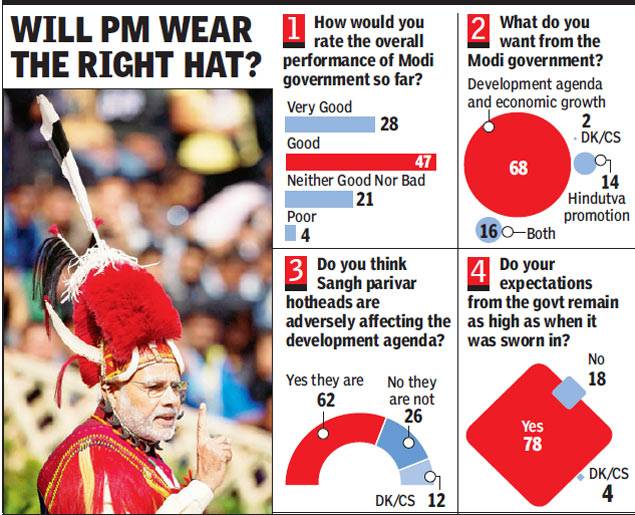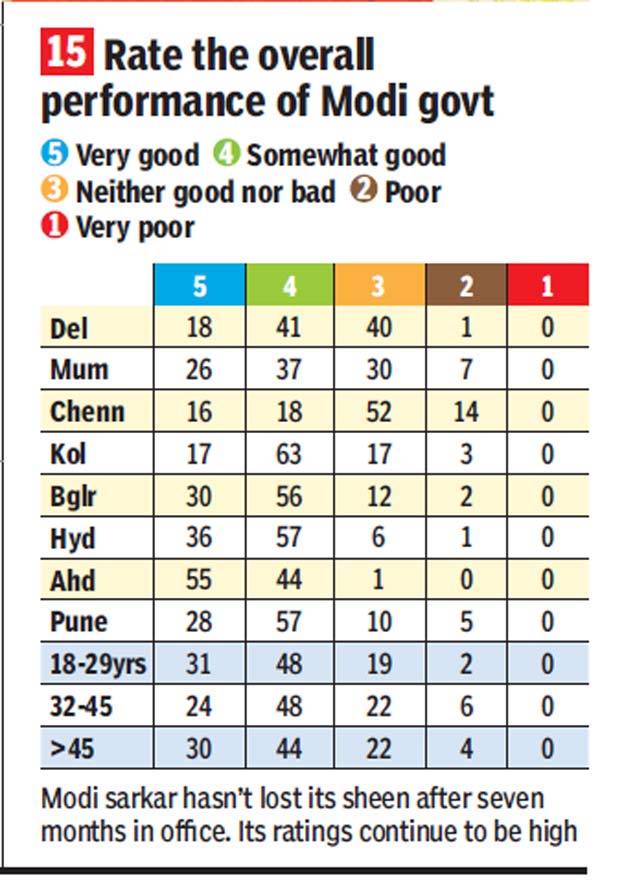Faith in Narendra Modi govt high, but Sangh hotheads a concern: TOI survey
TNN
New Delhi, 01 Jan 2015: It’s been seven months and five days since Narendra Modi was sworn in as India’s 15th Prime Minister, and he clearly retains the confidence and goodwill of the metropolitan middle class. His government is viewed by a majority of people in eight biggest cities to have done a good job so far and is expected to continue to do well.
However, there are strong apprehensions about Sangh Parivar hotheads derailing the development agenda. And development is viewed by the people as the key task for this government. Those are the big messages emerging from a survey conducted exclusively for TOI by IPSOS in Delhi, Mumbai, Kolkata, Chennai, Bangalore, Hyderabad, Pune and Ahmedabad.
The survey showed that 28% of those polled felt the government had done a very good job so far and another 47% felt its performance was good, the two approval figures adding up to three-quarters of respondents. As against this a mere 4% said the government had performed poorly, while the remaining 21% viewed it as so-so.
Given such high approval ratings, it is not surprising that expectations from the government remain very high. Over three-fourths of those polled (78%) said their expectations were just as high now as they were when the government was sworn in and only 18% said they weren’t. Managing these expectations will, therefore, be Modi’s biggest challenge.
And what do they expect from the government? Given a choice between development and economic growth, promotion of Hindutva and a combination of both, the verdict was quite clear — over two-thirds want the government to be focused on development and the economy. Less than one in seven (14%) saw promotion of Hindutva as the government’s key task and 16% wanted development and Hindutva to be the combined focus of the Modi government.
It is here that the survey holds a cautionary signal for the government. Asked whether hotheads of the Sangh Parivar were adversely affecting the government’s development agenda, nearly two-thirds (62%) said they were, while a quarter disagreed and the remainder 12% said they don’t hold a definite view on the issue.

The survey polled a little over 1,200 men and women aged 18 and above. The purposive sample was divided equally between men and women and between the cities. The age groups 18-29, 30-45 and 45-plus were equally represented in the sample as were socio-economic groups SEC A1, A2, B1 and B2. The fieldwork, in the form of face-to-face interviews, was done on December 27 and 28.

There are, however, significant variations in responses from different cities to questions put. One pattern that is fairly evident is that Chennai, Delhi and Kolkata are, in that order, least enamoured of the Modi government whereas Ahmedabad and Bangalore are most impressed by its performance so far and most optimistic about its future performance. This largely mirrors the voting trends of these cities in the LS elections, except in the case of Delhi. Whether the AAP effect is partly responsible for the national capital judging the Modi government in a harsher light than most other cities is a moot question.
This inter-city variation showed up most clearly when respondents were asked how they would rate the government’s overall performance. On a five-point scale in which 5 meant very good and 1 meant very poor, the effective score given by Ahmedabad was 4.54, which would mean very good. At the other end of the spectrum, the score given by Chennai was just 3.36, closer to average than to good.
 Write Comment |
Write Comment |  E-Mail To a Friend |
E-Mail To a Friend |
 Facebook |
Facebook |
 Twitter |
Twitter |
 Print
Print 


















